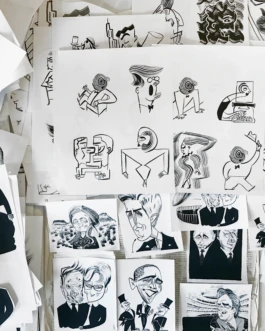What Have We Done?

The
Editor
A recent study published in the science journal PLOS One found that people are more successful at producing original solutions and practicing risk-taking when they take on a stereotypically uninhibited perspective. When it came to accessing one’s “unconscious mind,” the effect of adopting a persona was as powerful as resting and napping. In other words, assuming the role of a character stimulates new insights and surprising creativity. At Flat Out, we were encouraged to learn that our cause was supported by their results.
Well, in theory. We could never have imagined how much work it would take editorially to get those persona voices and tones right. Of course television show writers do this all the time, but at least their actors usually last more than one episode. It’s one thing to edit for content in an architectural magazine, but it’s another to edit for voice, or to understand that voice is also content. We found ourselves taking notes on every character, constantly updating our style sheet, and developing new rules as each author’s copy came in. The personas generated a level of bureaucracy that was unseemly.
And that was just for this issue. We realize now that our future entails the art of maintaining continuity from issue to issue: how to recognize identifiable characters despite different authors and topics? We plan to continue paying strategic attention to the technical details vis-à-vis the character to get there: the role of footnotes, personal asides, when to write in first, second, and third person, sentence structure, and so on. Fortunately, the challenge of continuity has yielded some unexpected surprises.
Across issues, we have discovered new ways of commenting within and on architectural discourse. In this issue, the Mortician and the Cameo took the liberty of referring to “their” essays in Flat Out 1, even though someone else had played those characters. We’re immensely grateful to these authors for showing us the light.
No doubt our process has been agonizing and baffling for other writers; comments ranged from “frankly, I don’t feel entirely comfortable adopting the voice” and “you guys are asking me to write a different piece” to “content first, then choose character or vice versa?” We thank all of them for their willingness to play, and for surviving the writes and rewrites as we figured things out on the job, so to speak. I’ve lost count of how often we said, “It will all be over soon!” We’re happy to report that now it is. Well, this episode, and for these actors at least.
As promised, we’ve tried some new things in this issue. We’ve rethought the Ad Man character and reconceptualized the advertorials. Having whined ad nauseam about the dearth of opinions, and belatedly coming to the realization that ads are always reviews, we figured it was time to put our money where our mouth is and take on the review genre ourselves. In this issue you will find Flat Out 1’s “Faves!” replaced by “Promotion Is Knowledge,” and the Ad Man opened to a wider set of contributors. The editors have given this collective persona a first shot here.

Illustrator Tom Bachtell’s studio desk in the Monadnock Building, Chicago, Illinois, May 5, 2017. Photo: James Goggin.
We are honored to have the New Yorker illustrator Tom Bachtell grace our pages with his Indian ink interpretations of the Flat Out personas. He brought them to life immediately after his DC “characters” were inaugurated in January (whose names we refuse to mention here). This back-to-back drawing of worlds took place in his Chicago studio. In the photograph accompanying this editorial, Flat Out’s art director, James Goggin, artfully captures the meeting of these two anomalous casts for two different magazines.
So, that just about sums up what we think we’ve done. According to our readers, we’ve done other things too. We won’t dwell too much on the positive feedback we received about Flat Out 1 (“good looking, daring, challenging, refined, critical, and engaged,” “very impressive and wonderful,” “vvvvv. smart,” “a super interesting intervention,” “really refreshing,” “the nom de plume works brilliantly,” “you are my kind of people,” and so on), but wish to draw your attention to the negatives. Remember, at Flat Out we love disagreement, and will always encourage and prioritize it here.
We’ve been told that our page margins are too small (the format precludes writing notes next to essays), our contents spread is “obnoxious” and “annoying” (readers shouldn’t have to flip back and forth for the first fifty words), and our character concept is redundant and sends some people “reeling” (why do you need a character to have an opinion? To which we reply, who said any of this was about need?). We’ve heard that the continuity between contents and essays is difficult to follow (too many fonts, titles, and character names), and that the Casting Call is misplaced at the back of the issue (please move it to the beginning, so the characters are introduced first).
In response, we say thank you for your feedback. Yes, we have heard you. Yes, we see your point. Yes, we will continue to challenge your conventions. And yes, it’s not easy being your kind of people.
The Editor was played by Penelope Dean in Flat Out 2 (Spring 2017).
Flat
Out
Benefactors
Graham Foundation for Advanced Studies in the Fine Arts
UIC Office of the Vice
Chancellor for Research
UIC College of Architecture, Design, and the Arts
Flat Out
Flat Out Inc. is a 501 (c) 3 tax-exempt not-for-profit organization registered in the state of Illinois.
Email editor@flatoutmag.org
This website is supported in part by the National Endowment of the Arts
Flat
Out
Benefactors
Graham Foundation for Advanced Studies in the Fine Arts
UIC Office of the Vice
Chancellor for Research
UIC College of Architecture, Design, and the Arts
Flat Out
Flat Out Inc. is a 501 (c) 3 tax-exempt not-for-profit organization registered in the state of Illinois.
Email editor@flatoutmag.org
This website is supported in part by the National Endowment of the Arts